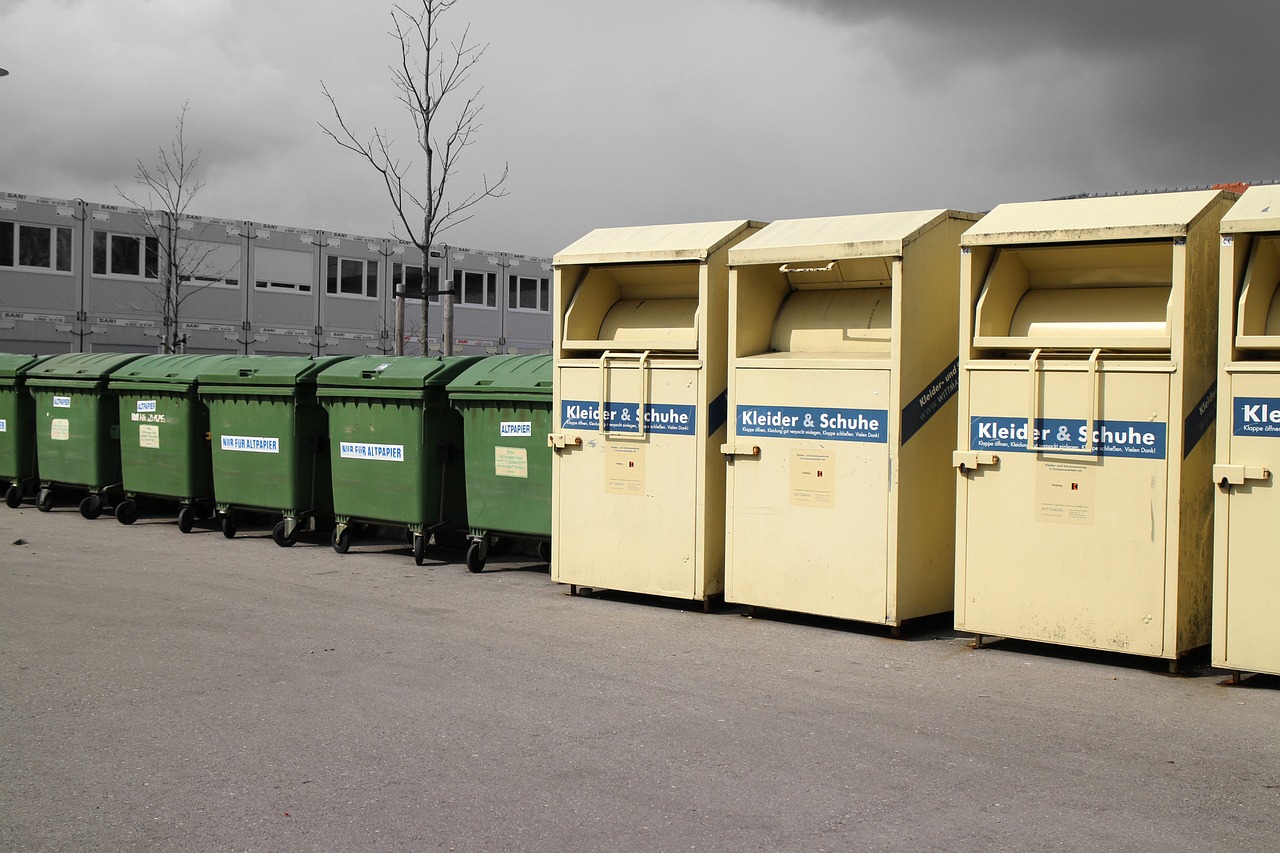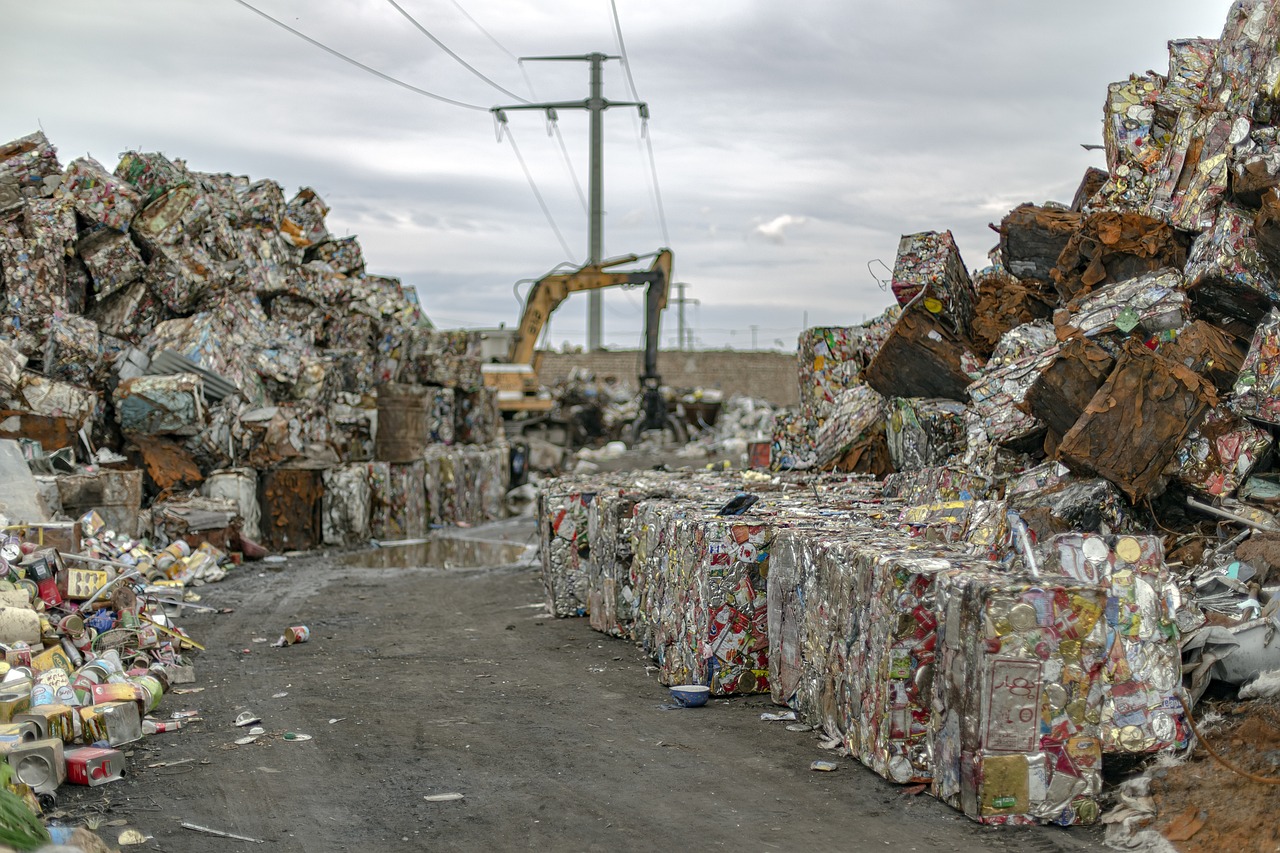Innovative Solutions to Dealing with Plastic Waste
Plastic waste is a growing concern that affects our environment, wildlife, and even human health. With millions of tons of plastic being produced each year, it’s time to explore innovative solutions that can help us tackle this pressing issue. From biodegradable alternatives to cutting-edge recycling technologies, there are numerous strategies being developed and implemented worldwide. This article dives deep into these solutions, showcasing successful initiatives and the roles that individuals, businesses, and governments play in the fight against plastic pollution.
In recent years, biodegradable materials have emerged as a sustainable solution to plastic waste. These materials break down naturally over time, reducing the environmental impact caused by traditional plastics. Imagine a world where your shopping bags, utensils, and packaging dissolve back into the earth instead of lingering for centuries. Biodegradable products can effectively replace conventional plastics in everyday applications, making them a crucial part of the solution. Some common biodegradable alternatives include:
- PLA (Polylactic Acid): Made from renewable resources like corn starch, PLA is used in food packaging and disposable cutlery.
- PHA (Polyhydroxyalkanoates): Produced by microorganisms, PHA is used for various applications, including packaging and agricultural films.
- Starch-based plastics: These are often used in bags and packaging and can break down in composting environments.
The benefits of these alternatives are not just environmental; they also offer economic opportunities. Businesses that adopt biodegradable materials can attract eco-conscious consumers, creating a win-win situation. However, it’s essential to ensure that these products are disposed of correctly to maximize their environmental benefits.
Advancements in recycling technologies are transforming how we manage plastic waste. Traditional recycling methods often struggle with the variety and contamination of plastics. However, new methods are enhancing recycling efficiency and expanding the range of plastics that can be processed. For instance, smart sorting technologies utilize AI and machine learning to identify and separate different types of plastics, ensuring that more materials are recycled effectively.
Chemical recycling offers a promising approach to breaking down plastics into their original monomers, which can then be reused to create new plastic products. This method can handle contaminated plastics that are typically unsuitable for mechanical recycling. By converting waste back into its fundamental components, chemical recycling has the potential to significantly reduce plastic waste. The processes involved may vary, but they generally include:
- Depolymerization: Breaking down polymers into monomers.
- Pyrolysis: Decomposing materials at high temperatures in the absence of oxygen.
The impact of chemical recycling on reducing plastic waste is substantial, as it allows for the recycling of materials that would otherwise end up in landfills or oceans.
Pyrolysis is a method that converts plastic waste into fuel, providing a dual benefit of waste reduction and energy production. This technology heats plastic waste to high temperatures, breaking it down into liquid oil, gas, and char. The benefits of pyrolysis include:
- Reducing the volume of plastic waste significantly.
- Producing a renewable energy source.
However, challenges remain in terms of scalability and the economic viability of pyrolysis plants. Overcoming these hurdles could lead to widespread adoption of this innovative technology.
Mechanical recycling remains a staple in waste management. Recent innovations in this area have improved the quality and efficiency of mechanically recycled plastics. Advanced shredders and granulators allow for better processing of plastic waste, while new washing technologies reduce contamination. These improvements mean that more recycled plastic can be used in manufacturing new products, leading to a circular economy where materials are continuously reused.
Grassroots movements play a vital role in tackling plastic waste. Community initiatives not only encourage recycling but also promote sustainable practices among residents. Local clean-up events, educational workshops, and recycling drives are just a few examples of how communities can come together to make a difference. These initiatives foster a sense of responsibility and empower individuals to take action against plastic pollution.
Government regulations are crucial in combating plastic waste. Effective policies and legislation can significantly reduce plastic production and promote sustainable alternatives. By implementing comprehensive strategies, governments can create an environment that supports innovation and encourages businesses and individuals to adopt more sustainable practices.
Many regions have implemented bans on single-use plastics. These policies have led to a noticeable shift in consumer behavior, prompting individuals to seek out reusable alternatives. The impact of these bans is profound, as they not only reduce plastic waste but also raise awareness about the environmental challenges we face. Communities that embrace these restrictions often see a decline in litter and pollution.
Governments are introducing incentives to encourage businesses and individuals to adopt sustainable practices. Programs such as tax breaks for using biodegradable materials, grants for recycling initiatives, and subsidies for renewable energy projects are becoming increasingly common. These incentives not only drive change but also demonstrate a commitment to protecting the environment.
Q: What are biodegradable plastics made from?
A: Biodegradable plastics are typically made from renewable resources, such as corn starch or other plant-based materials.
Q: How effective is chemical recycling?
A: Chemical recycling can be highly effective, especially for contaminated plastics that cannot be mechanically recycled.
Q: What can I do to reduce plastic waste in my community?
A: You can participate in local clean-up events, advocate for plastic bans, and educate others about sustainable practices.

Biodegradable Alternatives
In a world increasingly aware of the environmental challenges posed by plastic waste, are stepping into the spotlight as a promising solution. Unlike traditional plastics, which can take hundreds of years to decompose, biodegradable materials break down more quickly and naturally, significantly reducing their impact on our planet. These alternatives are not just a fleeting trend; they represent a fundamental shift in how we think about packaging and products.
One of the most exciting aspects of biodegradable materials is their diversity. From plant-based plastics made from corn starch to innovative products crafted from fungi, the options are expanding rapidly. For instance, companies are now producing biodegradable bags, utensils, and even packaging peanuts that dissolve in water! Imagine a world where your takeaway container doesn't just end up in a landfill but instead decomposes into harmless organic matter. This is not just a dream; it's becoming a reality.
Moreover, the benefits of using biodegradable alternatives extend beyond just reducing plastic waste. They often come from renewable resources, which means they can contribute to a more sustainable economy. For example, using materials derived from agricultural byproducts not only provides a solution to plastic waste but also supports local farmers and reduces reliance on fossil fuels. This creates a win-win situation for both the environment and the economy.
However, it’s crucial to note that not all biodegradable products are created equal. Some require specific conditions to decompose effectively, such as industrial composting facilities. This means that while a product may be labeled as biodegradable, it doesn’t guarantee that it will break down in a typical landfill environment. Therefore, consumer education is essential. People need to understand what biodegradable means and how to dispose of these products correctly to maximize their benefits.
To illustrate the potential impact of biodegradable alternatives, consider the following table that compares traditional plastics with biodegradable options:
| Feature | Traditional Plastics | Biodegradable Alternatives |
|---|---|---|
| Decomposition Time | 100-1000 years | 3 months to 2 years |
| Source | Fossil fuels | Renewable resources (e.g., corn, sugarcane) |
| Environmental Impact | High (landfill overflow, ocean pollution) | Lower (less landfill waste, compostable) |
| Cost | Generally cheaper | Often more expensive, but prices are decreasing |
As we navigate through this crucial transition, it’s essential for individuals, businesses, and governments to support the development and adoption of biodegradable alternatives. By choosing these products, we can collectively contribute to a more sustainable future. So, next time you reach for a plastic item, consider the biodegradable options available. It's a small change that can lead to significant impacts.
In conclusion, biodegradable alternatives are not just about replacing plastic; they are about rethinking our entire approach to consumption and waste. As we embrace these innovative solutions, we take a step closer to a cleaner, greener planet. Are you ready to make the switch?

Recycling Innovations
In recent years, the landscape of recycling has undergone a remarkable transformation, propelled by innovative technologies and creative approaches that challenge traditional methods. As we grapple with the overwhelming issue of plastic waste, these advancements not only enhance our recycling capabilities but also redefine our relationship with materials that have long been seen as disposable. Imagine a world where plastic waste is not merely tossed aside but is instead viewed as a valuable resource waiting to be repurposed. This shift in perspective is at the heart of the recycling innovations that are currently reshaping the industry.
One of the most exciting developments in recycling is the advent of smart recycling systems. These systems utilize artificial intelligence and machine learning to optimize the sorting process, ensuring that recyclables are correctly identified and processed. With the help of advanced imaging technology, these systems can differentiate between various types of plastics, metals, and other materials, significantly increasing recycling rates. It’s like having a super-smart assistant that knows exactly what to do with each item, minimizing contamination and maximizing efficiency.
Another groundbreaking approach is the emergence of chemical recycling. Unlike traditional mechanical recycling, which often degrades the quality of plastics, chemical recycling breaks down materials into their original monomers. This process not only allows for the recycling of a wider variety of plastics, including those that are typically non-recyclable, but it also enables the creation of high-quality raw materials that can be used to produce new plastics. Think of it as turning back the clock on plastic, restoring it to its original form, ready to be reimagined into something new.
Chemical recycling is a game-changer in the fight against plastic waste. By employing processes such as pyrolysis and depolymerization, this method converts plastics into oils, gases, or even back into their monomer building blocks. The potential for this technology is immense; it not only helps reduce the volume of plastic waste but also mitigates the need for virgin plastic production. As more companies invest in chemical recycling facilities, we can envision a future where plastic waste is seen not as a burden but as an opportunity for innovation.
Let’s dive deeper into pyrolysis technology, a fascinating method that converts plastic waste into fuel. Pyrolysis involves heating plastic waste in the absence of oxygen, which causes it to break down into smaller molecules. The end products are typically a mixture of oil, gas, and char, which can be further processed or utilized as energy sources. While this technology holds great promise, challenges such as high initial costs and the need for effective waste collection systems remain significant hurdles. However, as research continues and more pilot projects are launched, pyrolysis could revolutionize the way we approach plastic waste.
Mechanical recycling, while a more traditional method, has also seen a wave of innovations that enhance its efficiency and effectiveness. New techniques, such as advanced shredding and washing processes, have improved the quality of recycled plastics, making them more viable for reuse in manufacturing. Moreover, the development of better sorting technologies ensures that contaminants are removed, leading to higher purity levels in recycled materials. It’s akin to polishing a diamond; the more effort we put into the recycling process, the more valuable the end product becomes.
In conclusion, the innovations in recycling technologies are paving the way for a more sustainable future. By embracing these advancements, we can transform the way we view plastic waste—from a problem to be managed to a resource to be harnessed. As individuals, businesses, and governments work together to implement these technologies, we move closer to a world where plastic waste is no longer a burden, but a source of endless possibilities.
Q: What is chemical recycling?
A: Chemical recycling is a process that breaks down plastics into their original monomers, allowing for the creation of high-quality raw materials that can be reused in manufacturing.
Q: How does pyrolysis technology work?
A: Pyrolysis technology involves heating plastic waste in the absence of oxygen, breaking it down into smaller molecules, and producing oil, gas, and char that can be used as energy sources.
Q: What are smart recycling systems?
A: Smart recycling systems utilize AI and machine learning to optimize the sorting and processing of recyclables, increasing efficiency and reducing contamination.

Chemical Recycling
Chemical recycling is not just a buzzword; it's a revolutionary approach that promises to address the growing crisis of plastic waste. Unlike traditional recycling methods that often struggle with the degradation of plastic quality, chemical recycling breaks plastics down to their original building blocks, or monomers. This process allows us to create new plastics that are virtually identical to virgin materials. Imagine being able to recycle a plastic bottle and transform it back into a brand-new bottle! This is the magic of chemical recycling, and it opens up a world of possibilities for waste management.
The process typically involves several stages, including depolymerization, purification, and repolymerization. During depolymerization, the plastic is subjected to heat or chemicals that break it down into smaller molecules. Next, these molecules are purified to remove any contaminants, and finally, they are repolymerized to form new plastic. This method not only enhances the recycling rate but also increases the range of plastics that can be recycled, including those that are traditionally deemed non-recyclable.
One of the most exciting aspects of chemical recycling is its potential to reduce the overall carbon footprint associated with plastic production. By utilizing existing plastic waste, we can significantly lower the demand for fossil fuels, which are typically used to create new plastic. This shift can lead to a drastic reduction in greenhouse gas emissions and help combat climate change. However, like any innovation, chemical recycling comes with its own set of challenges. The technology is still in its infancy, and scaling it up for widespread use requires substantial investment and research.
Moreover, there are concerns regarding the energy consumption of chemical recycling processes. While they offer a more efficient way to recycle plastics, the energy required to break down and purify the materials can be significant. Therefore, it is essential to balance the benefits of chemical recycling with its energy demands to ensure that it remains a sustainable option.
In summary, chemical recycling represents a promising frontier in the battle against plastic waste. It offers the potential to not only recycle a greater variety of plastics but also to create high-quality materials that can be reused in countless applications. As we continue to innovate and invest in this technology, we may find ourselves on the path to a more sustainable future, where plastic waste is no longer a burden but a resource.
- What is chemical recycling? Chemical recycling is a process that breaks down plastics into their original monomers, allowing them to be reused to create new plastics.
- How does chemical recycling differ from traditional recycling? Traditional recycling often degrades the quality of plastics, while chemical recycling maintains or restores the original quality of the materials.
- What types of plastics can be chemically recycled? Many types of plastics, including those considered non-recyclable through traditional methods, can be processed through chemical recycling.
- What are the environmental benefits of chemical recycling? Chemical recycling can reduce the demand for fossil fuels, lower greenhouse gas emissions, and help manage plastic waste more effectively.
- Are there any challenges associated with chemical recycling? Yes, challenges include high energy consumption and the need for significant investment to scale the technology.

Pyrolysis Technology
When we think about solving the plastic waste crisis, one technology that stands out is pyrolysis. This innovative method is like a magic trick for plastics, transforming waste into valuable resources. But how does it work? Essentially, pyrolysis involves heating plastic waste in the absence of oxygen, which breaks down the materials into smaller molecules. This process results in the production of fuels, oils, and even gases that can be used for energy. Imagine turning yesterday's trash into today's fuel—it's a powerful concept!
One of the most exciting aspects of pyrolysis technology is its potential to address the massive amounts of plastic waste generated globally. According to recent studies, millions of tons of plastic end up in landfills every year. Pyrolysis offers a way to divert this waste from landfills, reducing environmental impact while simultaneously generating energy. The benefits are twofold: we tackle the plastic problem and create a renewable energy source.
However, like any technology, pyrolysis comes with its own set of challenges. For one, the initial setup costs can be significant, and the technology requires specialized equipment and knowledge to operate effectively. Additionally, the quality of the end products can vary based on the type of plastics used and the specific conditions of the pyrolysis process. But don't let these challenges overshadow the potential of this technology. With ongoing research and development, many companies are finding ways to optimize these processes and improve the output quality.
To give you a clearer picture, let's break down the pyrolysis process in a simple table:
| Step | Description |
|---|---|
| 1. Collection | Gathering plastic waste from various sources. |
| 2. Shredding | Reducing the size of the plastic waste for easier processing. |
| 3. Heating | Applying heat in an oxygen-free environment to break down plastics. |
| 4. Condensation | Collecting the vapors produced during the heating process. |
| 5. Refinement | Refining the collected products into usable fuels or chemicals. |
Moreover, pyrolysis technology is gaining traction globally, with several pilot projects and commercial plants emerging. Countries like the United States, Canada, and parts of Europe are investing in pyrolysis facilities to convert plastic waste into energy. These initiatives not only promote waste reduction but also stimulate local economies by creating jobs and fostering innovation.
In conclusion, while pyrolysis technology is not a one-size-fits-all solution, it certainly represents a promising avenue in our fight against plastic waste. By embracing this technology, we can pave the way for a more sustainable future, where waste is not merely discarded but transformed into valuable resources. It’s time to think differently about our plastic waste—after all, what if today’s garbage could fuel tomorrow’s energy needs?
- What types of plastics can be processed through pyrolysis? Most types of plastics, including polyethylene, polypropylene, and polystyrene, can be processed through pyrolysis, making it a versatile option for plastic waste management.
- Is pyrolysis environmentally friendly? While pyrolysis can reduce plastic waste and generate energy, it is essential to manage emissions and ensure that the process is conducted in a controlled environment to minimize environmental impacts.
- How does pyrolysis compare to traditional recycling methods? Unlike traditional recycling, which often requires the sorting and cleaning of plastics, pyrolysis can process mixed plastic waste without extensive pre-treatment, making it a more flexible approach.

Mechanical Recycling Techniques
Mechanical recycling is a cornerstone of waste management, serving as a crucial method for repurposing plastics that would otherwise contribute to the growing mountains of waste in our landfills and oceans. This technique involves collecting, sorting, and processing plastic waste into new products, making it a circular solution to the plastic crisis. Unlike chemical recycling, which breaks down plastics at a molecular level, mechanical recycling retains the integrity of the polymer structure, allowing for the creation of high-quality recycled materials.
One of the most significant advancements in mechanical recycling techniques is the development of enhanced sorting technologies. With the integration of artificial intelligence (AI) and machine learning, sorting facilities can now identify and separate various types of plastics with remarkable accuracy. This not only increases the efficiency of the recycling process but also ensures that more plastics are diverted from landfills. For instance, advanced optical sorting systems can distinguish between different colors and resin types, allowing for a more streamlined recycling operation.
Moreover, innovations in the shredding and granulation processes have led to improved quality of recycled materials. Shredders now come equipped with precision blades that minimize contamination and produce uniform particle sizes, which are essential for subsequent processing stages. The granulated plastic can then be melted and reformed into new products, ranging from packaging materials to textiles and even automotive parts. The versatility of mechanically recycled plastics is expanding, demonstrating that recycled materials can be just as functional as their virgin counterparts.
However, mechanical recycling is not without its challenges. The contamination of plastic waste remains a significant hurdle. Many consumers are unaware of the importance of cleaning and sorting their recyclables, which can lead to entire batches of materials being deemed unrecyclable. To combat this issue, educational initiatives are crucial. Communities must be informed about the correct recycling practices to ensure that the quality of the input materials is high enough to produce valuable recycled products.
Furthermore, the market demand for recycled plastics plays a pivotal role in the success of mechanical recycling. As businesses and consumers become increasingly eco-conscious, the demand for sustainable materials is on the rise. This shift in consumer behavior encourages manufacturers to incorporate recycled content into their products, creating a robust market for recycled materials. Initiatives like the Closed Loop Fund are also supporting the development of recycling infrastructure, making it easier for companies to source high-quality recycled materials.
In conclusion, mechanical recycling techniques are evolving rapidly, with advancements in technology enhancing their efficiency and effectiveness. As we continue to innovate and educate, the potential for mechanical recycling to mitigate plastic waste and contribute to a more sustainable future becomes increasingly promising. By embracing these techniques and supporting the recycling industry, we can all play a part in reducing our plastic footprint.
- What is mechanical recycling? Mechanical recycling is the process of collecting, sorting, and processing plastic waste into new products without altering the chemical structure of the plastics.
- How does mechanical recycling differ from chemical recycling? Mechanical recycling retains the polymer structure of plastics, while chemical recycling breaks them down into their original monomers for reprocessing.
- What are the main challenges of mechanical recycling? Contamination of recyclable materials and the fluctuating market demand for recycled plastics are significant challenges.
- How can consumers help improve recycling rates? Consumers can improve recycling rates by properly cleaning and sorting their recyclables, as well as supporting products made from recycled materials.

Community Initiatives
In the battle against plastic waste, grassroots movements have emerged as a powerful force for change. These not only raise awareness but also inspire individuals and local businesses to take action. Imagine walking through your neighborhood and seeing everyone actively participating in clean-up drives, recycling programs, and educational workshops. It’s a beautiful sight, isn’t it? These initiatives are critical as they foster a sense of responsibility and collective action among residents, creating a ripple effect that can lead to significant environmental impact.
One of the most effective ways communities are addressing plastic waste is through organized clean-up events. These gatherings not only help remove plastic waste from local parks, beaches, and streets but also serve as a platform for education. Participants often leave with a greater understanding of the importance of reducing plastic usage. For instance, in many cities, local schools partner with environmental organizations to host cleanup days, where students learn about the detrimental effects of plastic while actively contributing to their community. Such initiatives not only beautify the surroundings but also instill a sense of pride and ownership among residents.
Furthermore, community-led recycling programs have gained traction in various neighborhoods. These programs often involve setting up designated recycling stations where residents can drop off their plastic waste. Some communities even offer incentives for participating, such as discounts at local businesses or entry into raffles for eco-friendly products. The key to these programs is making recycling accessible and rewarding. For example, a recent initiative in a small town saw a 30% increase in recycling rates after introducing a system that rewarded households for their efforts. This demonstrates that when people feel their contributions are valued, they are more likely to participate.
Another innovative approach is the establishment of plastic-free challenges within communities. These challenges encourage residents to commit to reducing or eliminating their plastic consumption for a specified period. Participants often share their experiences on social media, creating a supportive network that motivates others to join in. The communal aspect of these challenges fosters a sense of camaraderie, as people share tips, struggles, and successes. It’s like a friendly competition where everyone wins by contributing to a healthier planet.
Moreover, local artisans and entrepreneurs are stepping up by creating alternatives to plastic products. Many communities are now hosting markets that feature handmade goods, such as reusable bags, beeswax wraps, and bamboo utensils. This not only promotes sustainable practices but also supports local economies. By choosing to buy from these vendors, residents can directly contribute to reducing plastic waste while fostering a sense of community pride.
To further support these initiatives, local governments can play a crucial role by providing resources and funding. Collaborating with non-profit organizations to create educational materials, hosting workshops, and offering grants for community projects can significantly enhance the impact of grassroots efforts. When communities feel supported by their local governments, it amplifies their motivation to tackle plastic waste.
In conclusion, community initiatives are vital in the fight against plastic waste. They empower individuals, foster collaboration, and create lasting change. Whether it's through clean-up events, recycling programs, or local markets, these grassroots movements demonstrate that every action counts. By coming together, communities can not only reduce plastic waste but also inspire others to join the cause, creating a cleaner, greener future for all.
- What are community initiatives? Community initiatives are local efforts aimed at addressing specific issues, such as plastic waste, through collective action and collaboration among residents.
- How can I get involved in my community's initiatives? You can get involved by participating in clean-up events, joining local recycling programs, or supporting local businesses that promote sustainable practices.
- What impact do these initiatives have? Community initiatives can significantly reduce plastic waste, raise awareness about environmental issues, and foster a sense of community pride and responsibility.

Government Policies
When it comes to tackling the ever-growing issue of plastic waste, play a pivotal role. These regulations not only shape how businesses operate but also influence consumer behavior, pushing society towards a more sustainable future. Governments around the world are recognizing the urgency of the plastic crisis and are taking significant steps to combat it. But what does this mean for us as individuals and for the environment?
One of the most effective strategies has been the implementation of plastic bans and restrictions. Many regions have taken bold steps to prohibit single-use plastics, which are notorious for their short lifespan and long-term environmental impact. For instance, countries like Kenya have enacted some of the strictest plastic bag bans, leading to a noticeable decrease in plastic waste in urban areas. This kind of legislation not only reduces the amount of plastic entering landfills but also encourages consumers to adopt more sustainable alternatives.
But it’s not just about banning plastics; it’s also about incentivizing sustainable practices. Governments are increasingly introducing programs that reward businesses and individuals for adopting eco-friendly practices. These incentives can take various forms, such as tax breaks for companies that use biodegradable materials or grants for community projects focused on recycling and waste reduction. For example, in several states in the U.S., businesses that implement comprehensive recycling programs can receive financial benefits, which not only helps the environment but also boosts their bottom line.
Moreover, education is a crucial component of these policies. Governments recognize that for any legislation to be effective, the public must understand the importance of reducing plastic waste. Campaigns aimed at educating citizens about the impact of plastic pollution and the benefits of recycling are becoming more common. These initiatives often include workshops, community events, and educational materials that explain how individuals can contribute to waste reduction efforts.
To illustrate the impact of these policies, let’s take a look at some statistics:
| Country | Plastic Waste Reduction (%) | Year of Policy Implementation |
|---|---|---|
| Kenya | 80% | 2017 |
| Canada | 50% | 2021 |
| European Union | 30% | 2021 |
As you can see, these policies are not just empty promises; they have tangible effects on reducing plastic waste. However, the effectiveness of these regulations largely depends on public compliance and the willingness of businesses to adapt. It’s a collaborative effort that requires commitment from all sectors of society.
In conclusion, government policies are essential in the fight against plastic waste. They serve as a framework that guides behavior, encourages innovation, and fosters a culture of sustainability. As individuals, we have a role to play too. By supporting these initiatives and making conscious choices in our daily lives, we can contribute to a cleaner, greener planet. So, what will you do to help reduce plastic waste?
- What are some examples of plastic bans? Many countries have banned plastic bags, straws, and cutlery. For instance, the European Union has enacted a ban on single-use plastic items.
- How do government incentives work? Governments may offer tax reductions or grants to businesses that implement sustainable practices, such as using biodegradable materials or improving recycling efforts.
- Why is education important in reducing plastic waste? Educating the public about the impacts of plastic pollution and how to recycle properly can significantly increase participation in waste reduction initiatives.

Plastic Bans and Restrictions
In recent years, the global community has awakened to the alarming effects of plastic pollution, leading to a surge in . These initiatives aim to curb the production and consumption of single-use plastics, which are notorious for their detrimental impact on the environment. Countries around the world are taking decisive action, implementing policies that not only limit plastic usage but also encourage more sustainable alternatives. But how effective are these bans, and what changes have they brought about in consumer behavior?
One of the most significant outcomes of these bans is the shift in public perception regarding plastic use. For example, when cities or countries enact bans on plastic bags, straws, or cutlery, they often witness a notable change in consumer habits. People begin to seek out reusable options—such as cloth bags or metal straws—as they become more aware of the environmental consequences of their choices. This behavioral shift not only reduces plastic waste but also fosters a culture of sustainability.
To illustrate the impact of these bans, let's take a look at a few regions that have implemented successful restrictions:
| Region | Type of Ban | Year Implemented | Impact |
|---|---|---|---|
| California, USA | Statewide ban on single-use plastic bags | 2016 | Reduced plastic bag use by 80% |
| European Union | Ban on single-use plastic straws and cutlery | 2021 | Promoted alternatives, leading to a 50% reduction in usage |
| New Zealand | Ban on plastic bags | 2019 | Encouraged the use of reusable bags, with a 90% drop in plastic bag consumption |
These examples highlight not only the effectiveness of plastic bans in reducing waste but also the broader societal shift towards environmental consciousness. However, it’s essential to recognize that bans alone are not a panacea. They must be accompanied by public education and the promotion of sustainable alternatives to ensure long-lasting change. For instance, many governments are implementing educational campaigns to inform citizens about the benefits of reducing plastic use and the importance of recycling.
Moreover, the success of these bans often hinges on the availability of alternatives. If consumers are to abandon single-use plastics, they need accessible, affordable, and convenient options. This is where businesses play a crucial role. By innovating and providing sustainable products, they can help facilitate this transition, making it easier for consumers to comply with new regulations.
In summary, plastic bans and restrictions are making waves in the fight against plastic pollution. They not only reduce plastic waste but also inspire a cultural shift towards sustainability. As these initiatives continue to gain momentum, it’s crucial for individuals, businesses, and governments to work together to create a cleaner, greener future. The journey towards a plastic-free world is undoubtedly challenging, but with collective effort, it’s entirely achievable.
Frequently Asked Questions
- What types of plastics are commonly banned? Many bans focus on single-use plastics such as bags, straws, and utensils.
- How can I adapt to these bans? Consider using reusable bags, metal straws, and bamboo cutlery as alternatives.
- Are there penalties for not complying with plastic bans? Yes, many regions impose fines or other penalties for violations of plastic bans.

Incentives for Sustainable Practices
In the battle against plastic waste, government incentives play a pivotal role in steering both businesses and individuals toward more sustainable practices. These incentives can take various forms, from financial grants and tax breaks to educational programs aimed at raising awareness about the importance of reducing plastic consumption. Imagine a world where every small business is rewarded for choosing sustainable materials over traditional plastics. Sounds appealing, right? Well, that's precisely what many governments are striving for!
One of the most effective ways to encourage sustainable practices is through financial incentives. For instance, some governments offer tax reductions for companies that implement eco-friendly practices. This not only lightens the financial burden on businesses but also motivates them to innovate and transition to greener alternatives. In fact, studies have shown that businesses that adopt sustainable practices often see an increase in customer loyalty and brand reputation. It’s a win-win scenario!
Moreover, grants and subsidies can help offset the initial costs of implementing sustainable technologies. For example, a small manufacturer looking to switch to biodegradable packaging might find it challenging to cover the upfront costs. However, with a government grant, they can make the switch without sacrificing their bottom line. This approach not only aids in reducing plastic waste but also fosters a culture of innovation within the business community.
But it's not just about businesses; individuals also play a crucial role in reducing plastic waste. Incentives aimed at consumers can significantly impact behavior. For instance, some regions have introduced cash-back programs for people who return plastic bottles or containers for recycling. This creates a tangible reward for environmentally friendly actions and encourages more people to participate in recycling initiatives. It's like a little nudge that transforms good intentions into real actions!
Furthermore, educational campaigns funded by government initiatives help raise awareness about the impact of plastic waste. These programs can be instrumental in changing public perception and behavior. By informing people about the benefits of reducing plastic usage and the available alternatives, governments can inspire a collective movement towards sustainability. After all, knowledge is power, and when people understand the consequences of their choices, they are more likely to make informed decisions.
To illustrate the effectiveness of these incentives, consider the following table showcasing various government programs aimed at promoting sustainable practices:
| Program | Description | Target Group |
|---|---|---|
| Tax Credits for Green Businesses | Reduces tax liability for businesses adopting sustainable practices. | Small to Medium Enterprises |
| Cash-Back Recycling Programs | Offers monetary rewards for returning recyclable materials. | General Public |
| Grants for Sustainable Projects | Financial support for projects aimed at reducing plastic waste. | Non-profits and Startups |
| Awareness Campaigns | Educational initiatives to inform the public about plastic waste. | All Citizens |
In conclusion, the role of government incentives in promoting sustainable practices cannot be overstated. By providing financial support, educational resources, and tangible rewards, governments can effectively drive change within communities and industries alike. As we work together toward a more sustainable future, it's essential that these incentives continue to evolve and adapt to meet the growing challenges of plastic waste. After all, every small change counts, and when we all do our part, we can create a significant impact!
- What types of incentives are most effective for encouraging sustainable practices? Financial incentives, such as tax breaks and grants, often prove to be the most effective in motivating businesses and individuals to adopt greener practices.
- How can consumers benefit from government programs aimed at reducing plastic waste? Consumers can benefit through cash-back recycling programs and educational initiatives that inform them about sustainable practices and alternatives to plastic.
- Are there any successful examples of government incentives reducing plastic waste? Yes, regions that have implemented cash-back programs and tax incentives for businesses have reported significant reductions in plastic waste and increased participation in recycling efforts.
Frequently Asked Questions
- What are biodegradable alternatives to plastic?
Biodegradable alternatives are materials designed to break down more quickly than traditional plastics, often made from natural substances like corn starch or sugarcane. These materials can significantly reduce environmental impact by decomposing naturally, thereby minimizing pollution and waste accumulation.
- How does chemical recycling work?
Chemical recycling involves breaking down plastic waste into its original monomers using various chemical processes. This approach allows for the recycling of plastics that are typically difficult to process mechanically, potentially increasing the overall recycling rates and reducing the need for new plastic production.
- What is pyrolysis technology?
Pyrolysis technology converts plastic waste into fuel through a thermal decomposition process in the absence of oxygen. This method not only helps reduce plastic waste but also produces valuable energy resources, although challenges such as cost and scalability remain in its implementation.
- What community initiatives are effective in reducing plastic waste?
Community initiatives that promote recycling, reduce plastic use, and encourage sustainable practices include local clean-up events, educational programs, and plastic-free challenges. These grassroots movements foster a sense of responsibility and collective action, empowering individuals to make a difference.
- What government policies are in place to combat plastic waste?
Governments around the world are implementing policies such as bans on single-use plastics, mandatory recycling programs, and incentives for businesses that adopt sustainable practices. These regulations aim to reduce plastic production and encourage the use of eco-friendly alternatives.
- How have plastic bans affected consumer behavior?
Plastic bans have led to a noticeable shift in consumer behavior, with many individuals opting for reusable bags, containers, and alternatives to single-use plastics. This change not only reduces plastic waste but also raises awareness about the environmental impact of plastic consumption.
- What incentives are available for adopting sustainable practices?
Incentives for sustainable practices can include tax breaks, grants for eco-friendly businesses, and subsidies for using biodegradable materials. These programs aim to motivate individuals and companies to embrace sustainability, ultimately contributing to a reduction in plastic waste.


















